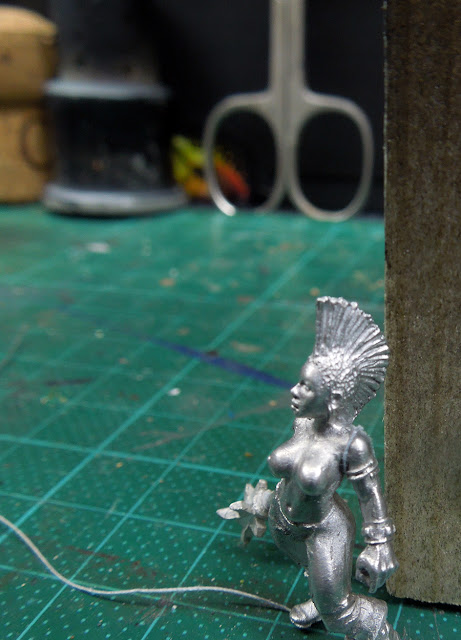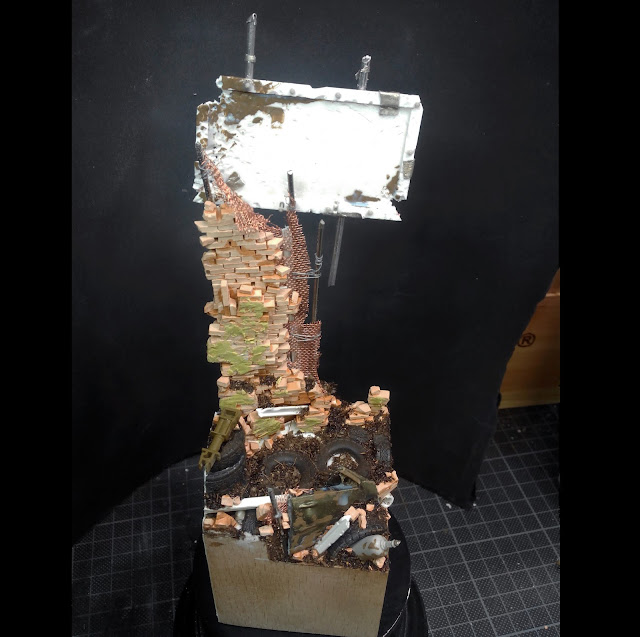
Good Morning Ladies and Gentlemen,
time for rolling out the result of your decision from this years first Tutorial Voting.
You voted and we are very happy to see over fifty people going with us carrying on tradtions.
The results are in and this weeks article is not Boudica. String won the race with thirty-eight votes.
Let's Boudica another day.
Roman will take you through the following article. We hope you enjoy and always remember if you like what we do here on MV feel invited to support us via jungle donation.
_________________________________________________________________________________
Hey there,
usually I say that 99,8% of all basing solutions can be done with the power of superglue and luck, but sometimes you want to have a construction that looks attached to something, not only glued. If you want to add more realism to your bases explain the viewer and gravity why something belongs where it is. Attached, not glued. Get inspiration from the real world, most common things around you are not just glued to the world.
Very important when working with string is: SCALE.
Check the scale your project is in, think about how big a small string must be if you scale it down. Take care by choosing the right scale for your project. A way to unrealistic big string on a 28 mm base looks ... weird, if you do not attach a ship to your base.
Different strings I use
I started working with string by accident years ago. I was in need of some and used some sewing thread from my girlfriend. Which is in fact in a good common scale for many projects and easy to get. I got three sorts of strings in my pockets when it comes to miniatures.
From left to right:
1. Mantua Model makes several sorts of strings (ship modelling),
2. Honestly I have no idea where I got this one from, but it's the smalles string I got
2. Sewing Thread (still the same from back then, it lasts a life time!)
The best friends you need when working with string:
Superglue & Toothpick & Patience
CONVERSION WITH STRING
Let's start right off with a small conversion I recently did on Hasslefree's Haydn in 28 mm.
I created a Wasteland Raider and thought about giving her a quick and easy shoulderpad of a skull plate. In this case the string is meant to be a small part of a robe to fix something.
I cut off some sewing thread - take care to rather take too much, maybe in my example it is a little bit too much, but in fact it is better to end up having some room to play instead of being out of string. Take your toothpick, pick up a tiny drop of superglue, place it where you want to add the string and add the string.
Now fix the string as you see fit.
Cut off the rest you do not need:
Glue the skull plate. Looks properly attached now. Skulls are from Origen Art.
Another example, but bad quality mobile photo, sorryio. I did a conversion from a Hasslefree Resin Model. Changed the head, the weapon, added armoury and a bag, attached with string.
Another example of strings being used to make something unique, I carefully glued roots and leaves to it later on.
Massive use of string here on this huge model.
While doing miniature conversion with string I recommend doing your build up first and using the string in the end if you want to attach something to something else.

For works like this I recommend listening to traditional japanese music to find your inner place. The place where you have enough patience to learn the mastery of string threading on miniatures.
Simple way of making a spear or a pipe more interesting or even hiding bad glueing areas is using string around it. Works really simple: Superglue, string and roll it.

Example, in this the string was used as rusty wire.
Conclusion:
Use it wisely, try to find sense in the things you connect and enjoy working with string. There is nothing you can do wrong badly. You might glue your fingers to the string, to your other fingers, to the toothpick, to an area you did not want to glue and so on. All mistakes you will find for yourselves and no one else can protect you from them. Just do it. Enjoy it. Work with your mistakes and learn from them.
________________________________________________________________________________
BASING WITH STRING
Let's start right off with a small conversion I recently did on Hasslefree's Haydn in 28 mm.
I created a Wasteland Raider and thought about giving her a quick and easy shoulderpad of a skull plate. In this case the string is meant to be a small part of a robe to fix something.
Again for basing it matters that you make your thoughts about the scale. The scale of your base, the scale of the miniatures on top and finally the scale of the string you want to use to imitate some rope or wire from the real world: SCALE.
Recently I started building a bigger base which is heavily inspired by Fallout 4. The base build up might look very chaotic so far, but for example string was used as rusted wire here:

... or rope. I see when I paint it and have to decide for a color.

Here some small parts of string where used as rusted wire to hold the remains of a fence:
In fact applying it is the same like doing a conversion. Toothpick, Superlgue and patience. In the next example it was used to build a rope where I attached small prayer flags, which were cut out of paper and superglued to the string.
Heavier and bigger strings can be used for miniatures in a larger scale or if you want to give barricades more weight. They look much more heavier if the rope used is big.
Can you find the string in here?

String used to keep the column standing. Well honestly superglue did already but it looked very fragile. With the string attached it feels much more secure now, eh? :D
A wild Troll by Red Box Games Miniatures, who has a collection of things he killed and found in the swamp. He plans to build up a castle in that style, but he did not come far yet.
In combination with the content of the article "Making easy tattered cloth" you can even add a wind direction in your game of flags and ropes. If you want a piece of rope hanging in the right wind direction play the game of superglue toothpick and move it to the rope that you hold still in the right position. Learn to master patience.
Another wind example:
And another one that shows wind and on the upper area two wood parts connected with rope.
Conclusion:
Ropes, wires and strings can be used on miniature projects to add a whole new level of detail. If you think about your construction work you will realize how often you might need them. I usually go fine with mainly using the sewing thread for most of my work with string.
There is no best way to do it. All I know has been mentioned in the article. That's how and what I use. I am sure some of you find their own ways. Enjoy!
Keep on happy painting!
Best Wishes
Roman


































As always great tutorial and a lot of inspirations. Thanks for sharing!
Thanks for that nice tut! And thanks for your first sentence:
"...usually I say that 99,8% of all basing solutions can be done with the power of superglue and luck,"
Like it :D
cheers
Siggi
Such a simple idea but with so many uses too.
Great tutorial.
What do you do to avoid the "fluff" that a thread gives - In my expirience most threads I have used have turned "flufft and wooly" after priming. Is it just a case of wrong thread or is there a trick?
Good Point, Mads. Well, usually I use a little bit of superglue or matte varnish to give more strength to the thread and avoid the "fluff" ...
... of course, before priming!
This is helpful! I've linked your work in my article: https://alkony.enerla.net/english/the-nexus/miniatures-nexus/miniature-hobby/miniatures-miniature-terrain-scenery-resources